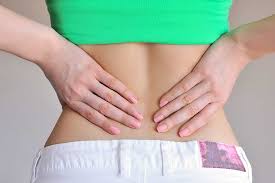Middle back pain
Middle back pain is a condition that many people suffer from. And while lower back pain seems to be the number one complaint, middle back pain (mid thoracic or mid scapular pain) is a very real concern for some people.
What is middle back pain?
If you experience pain anywhere between the bottom of your neck and the top of your rib cage, this page is referred to as middle back pain.
Before we take a look at what causes middle back pain, let’s do a quick recap on what the middle back is comprised of:
- There are 12 vertebrae in the middle back, which are attached to the rib cage
- Muscles and ligaments which hold everything together
- Discs that act as shock absorbers between each of the vertebrae

WHAT CAUSES MIDDLE BACK PAIN?
There are many causes of middle back pain. The most common causes include the following:
- Posture problems – slouching is very detrimental to the health of your entire body
- Repetitive use – any time you do something repetitively, it can cause you to suffer middle back pain
- Over use – if you’ve strained the muscles in your back or rib cage, middle back pain is often the result. Or is you have been sick with a cough and using a lot of your chest and back muscles, this can also be an overuse injury.
- Injury – any time you experience an injury to any of the bones, muscles or ligaments within the middle back, pain can be the result
- Osteoarthritis – this condition occurs when there is a breakdown of the cartilage that helps cushion the joints. Without this cushioning, you may experience middle back pain.
- Ankylosing spondylitis – a form of spinal arthritis
- Spinal stenosis – a narrowing of the open spaces within the spine
- Nerve-related problems – other nerve problems such as sciatica can cause middle back pain
- Fibromyalgia – widespread musculoskeletal pain and tenderness
- Osteoporosis – bone loss

How chiropractic helps those that suffer from middle back pain
Middle back pain can come on suddenly after an injury, or occur because of poor posture and chronic spinal misalignment. Chiropractic care can help reduce middle back pain, strengthen surrounding muscles and improve your posture. You aren’t prescribed medication by a chiropractor, and it is a form of therapy that can be used in conjunction with other forms of treatment. When you are experiencing middle back pain, a consultation with a chiropractor may lead to a significant improvement of your symptoms.
Spinal Adjustments and Back Pain
The National Center for Complementary and Integrative Health describes chiropractic as one of the most common complementary treatment options for better health used by both adults and children in the United States. The goal of adjustments is to get the spine into alignment, making it easier for the body to function. When the spine is aligned, the muscles, ligaments and tendons supporting the spine are less strained. As adjustments are done over time, the spine becomes better aligned overall and is able to maintain the alignment for longer periods of time.
Stretching and Middle Back Pain
Chiropractic is more than just spinal adjustments. You will talk with your chiropractor about stretching techniques to help improve flexibility and reduce pain. When your muscles are tight, the blood flow to the muscles is limited. By stretching your muscles, blood flow to the area resumes. Your muscle tissue is able to heal once you stretch the muscles well, allowing you to improve your overall posture and pain level.
Chiropractic Over Time
In the beginning stages of your treatment, you will visit a chiropractor several times a week. This is to get your spine used to being in alignment and to assess your condition on a consistent basis. As you heal, you will be taught ways to strengthen your back muscles to keep your spine in good alignment. Many patients visit a chiropractor for several months in order to deal with an acute situation, gradually decreasing to monthly visits for maintenance appointments.
Chiropractic as a Natural Approach
Back pain isn’t always an easy situation to remedy. Consequently, seeking professional help from a chiropractor is a natural approach and a wonderful first step to obtaining a solution. Furthermore, chiropractic isn’t going to interfere with other treatments. You can still be prescribed pain medication, go to acupuncture, or get a massage and still receive care from a chiropractor. If you are looking for ways to deal with middle back pain that don’t involve medication, chiropractic is an excellent option.
Through a series of chiropractic adjustments, your chiropractor will help restore the alignment of your spine. Hot or cold therapy may be used to reduce inflammation or improve circulation. Stretching is done to improve muscle flexibility and circulation. If an area of your spine is compressed and is causing you pain, decompression techniques may be used to reduce compression in the area. Chiropractic is a natural approach that will address pain and give your body the tools it needs to heal. When you are tired of middle back pain and want relief, it’s time to see how chiropractic can help

How do you reduce your risk of developing middle back pain?
While you may suffer from other pre-existing conditions that can cause middle back pain, that are out of your control, there are most definitely things you can do to reduce your risk of suffering from middle back pain.
If you slouch at work, focus on sitting up straight with your shoulders back and engage your core. Ensure that you have an ergonomic workstation that will be conducive to proper posture.
Go easy on activities that involve repetitive motion. It’s ok to do these activities once in a while, but if you do things repetitively day after day, you are very likely to develop middle back pain.
A “too soft” bed can also contribute to mid thoracic back pain!
At home treatment
Along with your ‘homework’ of performing the stretching exercises listed above, you should allow your body to get lots of rest. During sleep, the body does all sorts of things to recuperate, regenerate and restore.
Using a combination of heat and ice will help to reduce the inflammation causes by muscles strains, and will also loosen tight muscles, to allow for better overall functioning of the middle back.
Lifestyle changes
If you do things like sports or other activities that involve repetitive motion, it may be time to give it a rest until your back is fully healed. If you’re not able to give up the activity entirely, for example, if you
are addicted to golf, try reducing the amount of time you spend doing the activity. Even a slight change can be helpful.
If you work at a desk job, be sure that you practice good posture. As well, it might benefit you to have an ergonomics specialist visit your office to give you advice and information about how to make your work station more ‘user friendly’ and less conducive to causing posture issues that lead to middle back pain. You may also speak with your Chiropractor regarding recommending a stand-up desk as that puts much less stress on your mid thoracic and low back!



